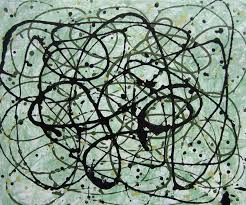The readings this week we raise the questions about the price of ART. About how we are schooled in art and how our creative content is marketed and we become embedded in the contemporary art market. How much is a painting worth? Who decides this? How do we as aspiring artists, who have committed to the higher education degree that will certify that we are professional artists, manage the art market? What connections do we need? Who are the collectors? And for those of us who are not partaking in the dance, where does that artist who creates for the sake of creation, fit into this market? Does art have meaning if it remains hidden from the rest of the world? And how is the market structured, who fuels the prices? An interesting story is the art of Kazuo Shirage.
The Art Market has rediscovered the work of the Japanese artist Kazuo Shiraga, pushing the market prices for his work from $300,000 in 2003 to over $1,000,000 in 2007, after a group of collectors visited Japan in the last few years (2005) and purchased every piece of art they could find on Shirage. His work is now sought after, due to the collectors and their desire to make their own purchases of his work more valuable.
 Kazuo Shiraga
Kazuo Shiraga  Shodo
Shodo Action Painting Shiraga
Action Painting Shiraga Kazuo Shiraga
Kazuo Shiraga Kazuo Shiraga
Kazuo Shiraga
 Action Painting
Action Painting  Jackson Pollack
Jackson Pollack Jackson Pollack
Jackson Pollack
The work of Kazuo Shiraga and Jackson Pollack are linked together by their common desire to incorporate the entire movement of the body in the work itself. Jackson Pollack’s style of painting,was referred to as ‘Action Painting’, Abstract Expressionism. When we study the work of both artists, we see a connection both in the methodology and execution of the paintings. The images of the back and white works, side by side, reflect the commonality of their work. Finding the books of the art and practice Kazuo Shiraga in Jackson Pollack’s studio, after his death, indicates that Pollack was interested, and perhaps very influenced by the style of the ‘Gutai’ artists in Japan. Shiraga was part of this group, and was also interested in the work of Jackson Pollack. “Gutai’ refers to the post-war art movement of abstract artists in the Osaka area, in the 1950’s. Inspired by the Japanese style of ‘Shodo’, a version of Japanese ink painting, using very large brushes, and using the art of meditation to ‘find’ the image in the blank paper, bith artists work intuitively. Working on the floor like Pollack, these paintings are very reminiscent of the work of Pollack. Shirage was sometimes suspended from ropes above his work, using only is feet to paint the image. These two artists, East and West, have a connection that I find very interesting.and each of them has seen a huge rise in the value of their work, after the deaths.